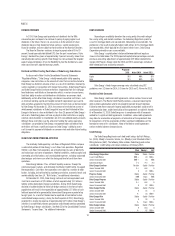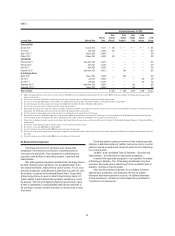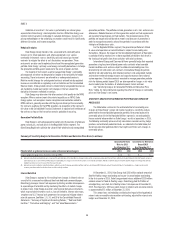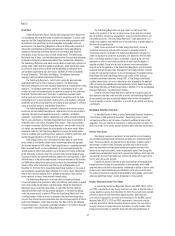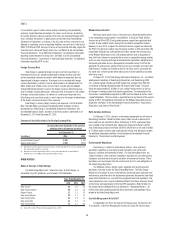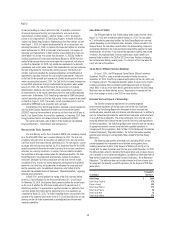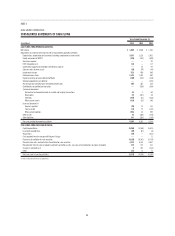Duke Energy 2014 Annual Report Download - page 78
Download and view the complete annual report
Please find page 78 of the 2014 Duke Energy annual report below. You can navigate through the pages in the report by either clicking on the pages listed below, or by using the keyword search tool below to find specific information within the annual report.
58
PART II
its investments against certain indices and by maintaining, and periodically
reviewing, target allocation percentages for various asset classes. Accounting
for nuclear decommissioning recognizes that costs are recovered through retail
rates; therefore, fl uctuations in equity prices do not affect their Consolidated
Statements of Operations as changes in the fair value of these investments are
deferred as regulatory assets or regulatory liabilities pursuant to an Order by the
NCUC, PSCSC and FPSC. Earnings or losses of the fund will ultimately impact the
amount of costs recovered through retail rates. See Note 9 to the Consolidated
Financial Statements, “Asset Retirement Obligations” for additional information
regarding nuclear decommissioning costs. See Note 15 to the Consolidated
Financial Statements, “Investments in Debt and Equity Securities” for additional
information regarding NDTF assets.
Foreign Currency Risk
Duke Energy is exposed to foreign currency risk from investments in
international businesses owned and operated in foreign countries and from
certain commodity-related transactions within domestic operations that are
denominated in foreign currencies. To mitigate risks associated with foreign
currency fl uctuations, contracts may be denominated in or indexed to the U.S.
dollar and/or local infl ation rates, or investments may be naturally hedged
through debt denominated or issued in the foreign currency. Duke Energy may
also use foreign currency derivatives, where possible, to manage its risk related
to foreign currency fl uctuations. To monitor its currency exchange rate risks,
Duke Energy uses sensitivity analysis, which measures the impact of devaluation
of the foreign currencies to which it has exposure.
Duke Energy’s primary foreign currency rate exposure is to the Brazilian
Real. The table below summarizes the potential effect of foreign currency
devaluations on Duke Energy’s Consolidated Statement of Operations and
Consolidated Balance Sheets, based on a sensitivity analysis performed as of
December 31, 2014 and December 31, 2013.
Summary of Sensitivity Analysis for Foreign Currency Risks
Assuming 10 percent devaluation in the currency
exchange rates in all exposure currencies
As of December 31,
(in millions) 2014 2013
Income Statement impact(a) $ (20) $ (20)
Balance Sheet impact(b) $ (98) $(140)
(a) Amounts represent the potential annual net pretax loss on the translation of local currency earnings to the
U.S. dollar in 2014 and 2013, respectively.
(b) Amounts represent the potential impact to the currency translation through Accumulated Other
Comprehensive Income (AOCI) on the Consolidated Balance Sheets.
OTHER MATTERS
Ratios of Earnings to Fixed Charges
The Duke Energy Registrants’ ratios of earnings to fi xed charges, as
calculated using SEC guidelines, are included in the table below.
Years Ended December 31,
2014 2013 2012
Duke Energy(a) 3.2 3.0 2.4
Duke Energy Carolinas 4.6 4.4 3.8
Progress Energy 2.7 2.2 1.6
Duke Energy Progress 3.5 3.7 2.3
Duke Energy Florida 4.1 2.9 2.3
Duke Energy Ohio 2.1 2.2 1.7
Duke Energy Indiana 4.1 4.1 0.3
(a) Includes the results of Progress Energy beginning on July 2, 2012.
Midwest Generation Exit
Merchant power plants have, in the recent past, delivered volatile returns
in the competitive energy markets in the Midwest. In Ohio, the Public Utilities
Commission of Ohio (PUCO) had granted revenue support from regulated retail
markets to help stabilize returns during the transition to competitive markets.
However, in early 2014, a request for continued revenue support was denied by
the PUCO. This decision made it clear the energy markets in Ohio were to be fully
unregulated. Although the undiscounted cash fl ows recover the carrying value
of the Midwest Generation assets, the recovery period is over a long period of
time, with risks inherent in operating these assets in competitive energy markets
and in an ever changing landscape of environmental regulations related to fossil
fuel based generation sources. Management concluded in early 2014 that the
projected risk and earnings profi le of these assets was no longer consistent with
Duke Energy’s strategy and initiated a plan to sell these assets and realize the
fair value over a shorter period while reducing the risk and volatility associated
with these assets.
On August 21, 2014, Duke Energy Commercial Enterprises, Inc., an indirect
wholly owned subsidiary of Duke Energy Corporation, and Duke Energy SAM,
LLC, a wholly owned subsidiary of Duke Energy Ohio, entered into a PSA with
a subsidiary of Dynegy whereby Dynegy will acquire Duke Energy’s Disposal
Group for approximately $2.8 billion in cash subject to adjustments at closing
for changes in working capital and capital expenditures. The completion of the
transaction is conditioned on approval by FERC and the release of certain credit
support obligations. The transaction is expected to close by the end of the second
quarter of 2015. For additional information on the Midwest generation business
disposition see Note 2 to the Consolidated Financial Statements, “Acquisitions,
Dispositions and Sales of Other Assets.”
North Carolina Ash Basins
On February 2, 2014, a break in a stormwater pipe beneath an ash basin at
Duke Energy Carolinas’ retired Dan River steam station caused a release of ash
basin water and ash into the Dan River. On February 8, 2014, a permanent plug
was installed in the stormwater pipe, stopping the release of materials into the
river. Duke Energy Carolinas estimates 30,000 to 39,000 tons of ash and 24 million
to 27 million gallons of basin water were released into the river during the incident.
For additional information see Note 5 to the Condensed Consolidated Financial
Statements, “Commitments and Contingencies.”
Environmental Regulations
Duke Energy is subject to international, federal, state, and local
regulations regarding air and water quality, hazardous and solid waste
disposal, and other environmental matters. The Subsidiary Registrants are
subject to federal, state, and local regulations regarding air and water quality,
hazardous and solid waste disposal and other environmental matters. These
regulations can be changed from time to time and result in new obligations of
the Duke Energy Registrants.
The following sections outline various proposed and recently enacted
regulations that may impact the Duke Energy Registrants. The Duke Energy
Registrants also expect to incur increased fuel, purchased power, operation and
maintenance, and other costs for replacement generation for potential coal-fi red
power plant retirements as a result of these proposed and fi nal regulations. The
actual compliance costs may be materially different from these estimates based
on the timing and requirements of the fi nal EPA regulations. Refer to Note 4 to
the Condensed Consolidated Financial Statements, “Regulatory Matters,” for
further information regarding potential plant retirements and regulatory fi lings
related to the Duke Energy Registrants.
Coal Ash Management Act of 2014
On September 20, 2014, the Coal Ash Act became law. The Coal Ash Act
(i) establishes a Coal Ash Management Commission (Coal Ash Commission)





